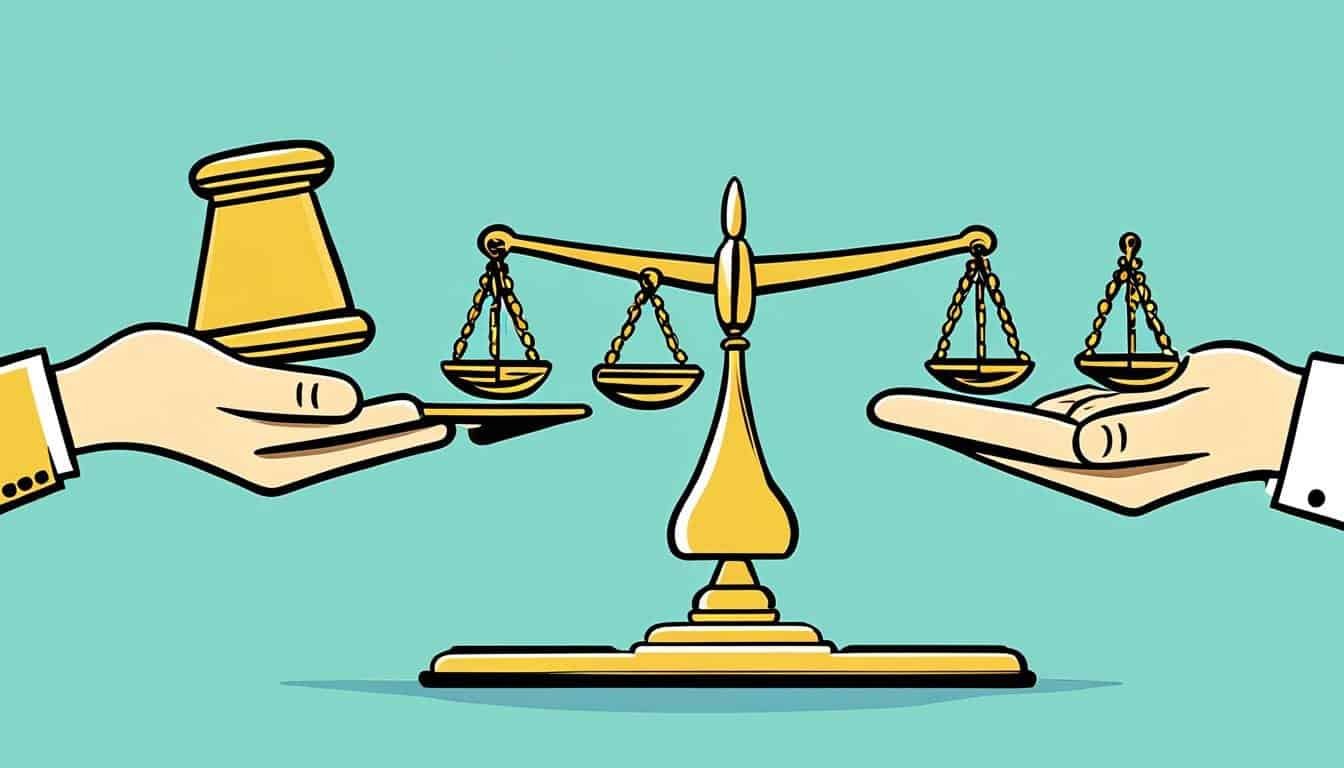Legal and Judicial Conflict Resolution Methods
“In the middle of difficulty lies opportunity.” – Albert Einstein
Legal and Judicial Conflict Resolution Methods offer new ways to solve disputes. They include strategies like negotiation, mediation, and arbitration. These methods help save time, cut costs, and keep relationships strong.
Only 5% of all cases end up in court, showing how important these methods are. Mediation helps both sides find a solution that works for everyone. Arbitration is quicker and cheaper than a full trial.
Many court cases settle before trial, showing the value of early dispute resolution. Courts often ask for these methods before starting a lawsuit. This helps solve conflicts faster and avoids long legal fights.
Key Takeaways
- Methods like negotiation, mediation, and arbitration are key to avoiding traditional lawsuits.
- Only 5% of cases make it to trial, with most settling through other means.
- Mediation encourages both sides to work together for a win-win outcome.
- Arbitration is faster, less formal, and often cheaper than going to court.
- Courts often make parties try these dispute resolution processes before going to court.
Understanding Conflict Resolution in Law
Conflict resolution in law is key to settling disputes without long, costly court battles. It uses both informal and formal ways to help parties find peace. Now, many see traditional court fights as less ideal because of their problems.
Definition and Importance
Law conflict resolution means finding ways to solve disputes. These include talking things out, mediation, arbitration, and going to court. Negotiation and mediation are cheaper and easier to get into than arbitration and court fights. They are vital for keeping relationships strong and stopping things from getting worse.
Conflict resolution is important for working together better, improving relationships, and making a peaceful workplace. Skills like listening well, controlling emotions, and negotiating are key to settling disputes well.
Challenges in Traditional Litigation
Traditional court fights have big problems that make them less popular. Long waits, high costs, and sharing private info are the main issues. In civil cases, a judge or jury listens to both sides, with lawyers leading the way. This means private info might become public, which some don’t want.
Also, court fights can make conflicts worse because they focus on winning against each other. This can make stress and emotions run high. So, many choose other ways to solve disputes, like mediation and arbitration, to avoid these issues and find quicker, private solutions.
Overview of Alternative Dispute Resolution (ADR) Techniques
Alternative Dispute Resolution (ADR) is now a popular way to settle disputes without going to court. It offers many benefits, making it a good choice for many legal issues. In the 1970s, ADR was first tried out. By 1990, Congress made it official with laws supporting it. By the 1990s, three key laws encouraged its use and helped provide ADR options in federal courts.
Types of ADR
ADR uses different methods to help settle disputes in a way that’s faster and less confrontational than court. Some common ADR methods are:
- Mediation: A neutral person, called a mediator, helps the parties agree on a solution. This method is flexible and can lead to creative solutions.
- Arbitration: This is a more formal process where an arbitrator makes a final decision after hearing the evidence. It’s often used in labor disputes.
- Conciliation: Like mediation, but focuses on improving the relationship between the parties. It usually ends in non-binding agreements unless made official.
- Early Neutral Evaluation: Offers non-binding opinions to help parties understand their case and possible outcomes.
- Private Judging: Uses a neutral expert, often a former judge, to make final, binding decisions.
Advantages of ADR
ADR has many benefits that make it popular. It’s known for being quicker than going to court. It often leads to solutions that meet both sides’ needs. Plus, it can save money by avoiding long, costly court battles.
Another big plus is that ADR keeps sensitive information private. This is important in business and family disputes.
Key Considerations
When thinking about ADR, keep these points in mind:
- Choosing the right method: Picking an ADR technique that fits the dispute is key.
- Ensuring procedural fairness: A fair process is vital for a valid outcome.
- Creating binding agreements: If needed, making agreements official ensures everyone follows the decision.
By considering these factors, parties can use ADR to find good solutions without going to court.
Negotiation in Legal Disputes
Negotiation is a key way to settle disputes by talking directly to find solutions everyone can agree on. It’s flexible and can happen at any point in a dispute. Using negotiation can save money on legal fees and give both sides more control over the outcome.
Definition and Process
In legal disputes, negotiation means talking to reach an agreement without outside help. The people involved might be the disputing parties or their lawyers and other experts. The way you negotiate can greatly affect the outcome. You can choose from competitive or cooperative methods, with principled bargaining focusing on fairness and mutual gain.
When to Use Negotiation
Use negotiation when you want to keep a good relationship after the dispute, when you want it to stay private, or when you need creative solutions. It works well in cases like business and family law where settling out of court is preferred. The Treasury Board Contracting Policy also suggests negotiation for quick and effective contract disputes resolution.
Advantages and Disadvantages
There are big advantages to using negotiation in legal disputes:
- It’s cheaper than going to court
- It helps keep relationships strong
- It keeps things private
- It gives you control over the outcome
But, there are also downsides:
- Power differences can skew the results
- It lacks a formal structure
- It can lead to tricky or unfair moves
In the end, negotiation has many benefits for settling disputes. But, knowing its limits and preparing well can help avoid its downsides. This ensures a fair and just solution for everyone.
Mediation: An Effective ADR Method
Mediation is now a top choice for solving legal disputes outside of court. It’s different from going to court, where a judge makes the final call. In mediation, both sides work together with a neutral person called a mediator. This section looks at the mediator’s role, how mediation works, and its benefits.
Role of the Mediator
The mediator’s role is key in mediation. They act as a helper, not a judge. The mediator helps both sides talk clearly, understand what they need, and find solutions. They stay neutral to make sure mediation is fair and promotes teamwork.
Mediation Process
The mediation process has a clear but flexible plan:
- Initial Meeting: The mediator explains the process and sets the rules.
- Statements: Each side shares their side of the story without interruptions.
- Discussion: The mediator leads a conversation, sometimes in private meetings with each side.
- Negotiation: The mediator helps the sides work out a deal.
- Agreement: If they agree, the mediator writes up the agreement.
This approach, thanks to the mediator, creates a safe and controlled space. It leads to open talks and quick solutions.
Benefits of Mediation
Mediation has many advantages:
- Cost-Effective: It’s cheaper than going to court.
- Time-Saving: Cases often get settled faster in mediation than in court.
- Confidentiality: Mediation talks are private, unlike court trials which are public.
- Preservation of Relationships: Mediation helps people work together, which is key in ongoing conflicts like family or business issues.
- Creative Solutions: Mediation lets people find unique solutions that might not be possible in court.
With so many benefits, it’s easy to see why mediation is a top choice for solving disputes in a friendly way. It focuses on the mediator’s role and offers a flexible process. This makes mediation a growing alternative to going to court.
Arbitration in Legal Disputes
Arbitration is a top choice for solving legal disputes because it’s flexible, private, and quick. It’s faster and cheaper than going to court. This makes it great for those looking for a quick and cost-effective way to settle disputes.
Types of Arbitration
Arbitration has different types, each suited for different kinds of disputes. The main arbitration types are:
- National Arbitration: This type deals with disputes within one country’s laws.
- International Commercial Arbitration: This type involves disputes between parties from different countries and follows international rules like the New York Convention.
Arbitration Process and Procedures
The arbitration process starts with an agreement to use arbitration for solving disputes. Parties can choose to have one arbitrator or a panel, depending on the case. The process is more flexible than court proceedings, including:
- Submitting the dispute to arbitration under an agreement.
- Choosing the arbitrator(s).
- Private hearings where each side presents their case.
- A final decision by the arbitrator, which can be binding or non-binding, depending on the agreement.
This method usually settles disputes much faster than going to court, which can take years.
Benefits and Limitations of Arbitration
Arbitration has many advantages:
- Subject Matter Expertise: You can pick arbitrators with the right knowledge for your case.
- Privacy and Confidentiality: Arbitration keeps everything private, protecting sensitive info.
- Cost-Effective: It’s usually cheaper because it’s faster and simpler than court.
- Flexibility: You can decide on the rules, language, and location, avoiding biases.
But, there are some downsides:
- Enforcement Challenges: Arbitration awards can be tough to enforce, especially across borders.
- Limited Appeal Options: You have fewer chances to appeal arbitration decisions.
- Costs for Complex Disputes: While it’s often cheaper, complex cases can get pricey with multiple arbitrators.
In conclusion, knowing the arbitration benefits and limits helps people make better choices when settling disputes.
Court-Annexed Mediation
Court-annexed mediation programs are key in solving conflicts in courts today. They use mediation and other ADR methods right in court, making disputants try to settle before going to court. This approach helps ease the court’s workload, speeds up case endings, and lowers costs for everyone.
These programs are getting more popular and show great results. For example, the Eastern District of New York (EDNY) celebrated 30 years of its ADR Program on October 17, 2023. The Rapid Mediation Pilot, for cases delayed by the pandemic, shows how courts are innovating in judicial mediation.
In Virginia, the Division of Dispute Resolution Services has broadened court-annexed mediation. This gives people many ways to solve disputes, like early neutral evaluation, conciliation, and judicial mediation. This was made possible by the 34-member Commission on the Future of Virginia’s Judicial System. House Bill No. 818 in 2002 made mediation more secure and protected.
Nebraska has seen a big increase in mediation and restorative justice cases, over 69,000 through approved centers. The Nebraska judiciary keeps updating its mediation services to make them better and easier to use. This shows how important judicial mediation is for solving conflicts.
Events like the Mediator’s Proposal Workshop on June 4, 2024, with 76 people, and the panel on New York Employment Law changes on May 8, 2024, show mediation’s ongoing importance. They highlight how court-annexed mediation keeps evolving and staying relevant in the legal world.
Litigation Avoidance Strategies
In today’s legal world, it’s key for businesses and individuals to use litigation avoidance strategies. Legal fights can be very costly, with expenses often higher than expected. These costs include legal fees, time lost, stress, and missed chances.
Even cases that seem strong can fail up to 10% of the time. This shows how risky going to court can be.
Mediation is a great way to avoid courtroom litigation. It’s more successful than going to court in settling probate issues. Mediators work to find solutions that everyone can agree on.
Using strong negotiation skills can also stop disputes from getting worse. Instead of being aggressive, negotiating can lead to good outcomes. Clear talking is important, and keeping lawyer-client talks private can lower legal risks.
Writing clear agreements is another important strategy. Vague contracts often lead to disagreements. Training employees yearly can also help prevent workplace issues from becoming legal problems.
It’s important to follow contract rules to keep trust and avoid legal fights. Quickly reporting insurance claims can solve problems fast. Also, filing lawsuits on time keeps your legal claims valid and avoids losing out due to missed deadlines.
Getting legal advice early, even for simple agreements, can prevent future problems. This step can save a lot of money and time compared to going through a long legal battle.
Elder Law firms have avoided legal fights in 70% of cases with smart legal strategies. This shows how effective being proactive can be in avoiding legal issues in different areas.
Legal Conflict Management Techniques
Managing legal conflicts requires both proactive and reactive steps. Using preventive strategies, improving communication, and getting help from legal experts can stop disputes early. It’s key for people and groups to know these methods to lower risks and keep relationships smooth.
Preventative Measures
Preventing conflicts is key. Having solid agreements and clear rules helps a lot. For instance, a company might make detailed contracts that cover all bases, avoiding misunderstandings. Also, strong policies guide actions and decisions, stopping conflicts before they start.
Effective Communication Strategies
Good communication is vital in managing legal conflicts. Bad communication can lead to big misunderstandings and fights. By talking openly and honestly, issues can be solved early. Listening well and sharing concerns without fighting is important. Also, understanding the real reasons behind disputes helps find better solutions.
Role of Legal Counsel
Legal advisors play a big role in solving conflicts. They offer advice on how to avoid conflicts and can help in mediation and arbitration. Their knowledge makes sure everyone’s rights are looked after and solutions follow the law. They also turn agreements into legal contracts, setting the stage for future dealings.
Conclusion
This article has shown us many ways to solve legal disputes without going to court. We’ve seen how negotiation, mediation, and arbitration can help. These methods let people and businesses find solutions that are quick and keep relationships strong.
Knowing about these methods is key to handling legal issues well. With good planning and negotiation skills, and help from legal experts, many disputes can be solved outside court. This shows how important it is to tailor solutions to each case, looking at things like the laws and the specific situation.
Studies and real-life examples, like Amy Cooper’s case solved through therapy, show us new ways to deal with conflicts. These new methods are part of a bigger change towards solving problems in a more caring and helpful way. As we see more of these methods being used and improved, we’re moving towards solving legal conflicts in a smarter, fairer way.
Source Links
- Resolving disputes – think about your options
- Methods for Resolving Conflicts and Disputes – Oklahoma Bar Association
- What are the Three Basic Types of Dispute Resolution? What to Know About Mediation, Arbitration, and Litigation
- What is Conflict Resolution, and How Does It Work?
- North Central College
- alternative dispute resolution
- Introduction
- Alternative Dispute Resolution (ADR) Programs
- Dispute Resolution Methods: Uses of Alternative Dispute Resolution | Davis Wright Tremaine
- Dispute Prevention and Resolution Services
- Litigation and Alternative Dispute Resolution
- Mediation / Alternative Dispute Resolution
- Minnesota Judicial Branch – ADR
- Arbitration vs. Litigation: Choosing the Right Path
- What is Arbitration?
- Overview of Arbitration & Mediation
- Alternative Dispute Resolution | Eastern District of New York
- About – Dispute Resolution Services/Mediation
- NEBRASKA MEDIATION
- Top 7 Tips to Avoid Litigation
- Eight Tips to Avoid Litigation | AmTrust Financial
- 10 Simple Steps to Avoid Litigation – Michaelson Law
- Conflict Management & Litigation – Colligan Law, LLP – Buffalo, NY
- 5 Conflict Resolution Strategies
- Five Conflict-Resolution Strategies for the Workplace
- Conflict of laws | Definition, Principles, Examples, Importance, & Facts
- Alternative Dispute Resolution Examples: Restorative Justice







